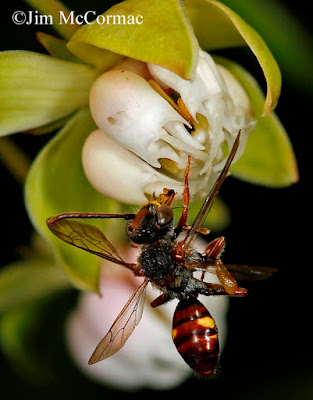The downward spiral of the Monarch has brought milkweed plants into a limelight they've never enjoyed before. That's because milkweeds serve as the host plants for the butterfly above - the only plants that the butterfly's caterpillars can eat. Nurseries can hardly keep the stuff in stock. The people have spoken - they want to protect Monarchs. Milkweeds are their ammo.

But milkweeds do FAR more than just service Monarchs. This Butterfly Milkweed, Asclepias tuberosa, is awash in Spicebush Swallowtails, with a few Great Spangled Fritillaries thrown in for good measure.
Next Wednesday evening, commencing at 7 pm., I am giving a talk entitled Milkweeds, Monarchs, and More at the fabulous Grange Insurance Audubon Center near downtown Columbus. CLICK HERE for details. It's free, and all are welcome.
The "and More" part of my talk title will be lived up to. Milkweeds host many other animals, a number of which only use these plants, such as this amorous pair of Red Milkweed Beetles. I will share many milkweed species, one of which is a stunning, state-endangered moth.
The bizarre spidery maroon flowers of a strange vining milkweed, Angle-pod, Matelea obliqua, a rarity in Ohio. It is the only representative of its genus in Ohio.
A whopping big milkweed is the Poke Milkweed, Asclepias exaltata. In sum, there are thirteen species of Asclepias milkweeds in Ohio, and it is a varied lot. However, to a plant they are all beautiful, and incredibly valuable to wildlife.
While showy butterflies garner the lion's share of attention when it comes to milkweed visitors, the plants probably attract more moths. We just don't notice, since many of their visits take place under cover of darkness. This tiny species is a Buck's Plume Moth, and they love milkweed nectar. They're so tiny as to be dismissed as a gnat or mosquito, if noticed at all.
Successful milkweed pollination is synced to powerful bumblebees; lesser creatures beware. This small wasp learned the hard way the perils of entering the sphere of a milkweed flower. It became entrapped, and perished.
I'm going to range through the interesting links between milkweeds and humans, show the varied species and what makes them tick, and discuss some of the fascinating animals whose fortunes are tied, in some cases inextricably, to milkweeds. And end it all with a cool example of something that anyone with a small plot can do to make the world a better place with milkweeds and prairie plants.
Hope you can make it! Again, CLICK HERE for details.






2 comments:
It's a lovely prairie with great diversity!
Does the higher traffic concentration surrounding a highly urban ecosystem have any effect on the mortality rate of the creatures who utilize it? I would think there would be more car strikes.
Not at our site, Jain. The prairie is in the middle of our complex, well away from busy roads, so car mortality is not an issue. Might be at roadside sites but don't know of any studies to bear that out one way or another.
Jim
Post a Comment